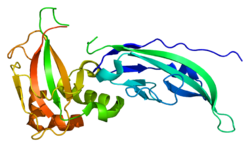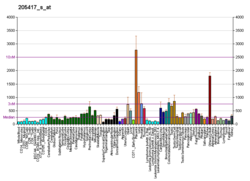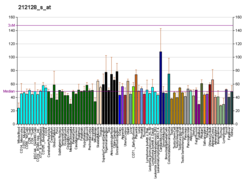Dystroglycan is a protein that in humans is encoded by the DAG1 gene.[5][6][7]
Dystroglycan is one of the dystrophin-associated glycoproteins, which is encoded by a 5.5 kb transcript in Homo sapiens on chromosome 3.[8] There are two exons that are separated by a large intron. The spliced exons code for a protein product that is finally cleaved into two non-covalently associated subunits, [alpha] (N-terminal) and [beta] (C-terminal).
- ^ a b c GRCh38: Ensembl release 89: ENSG00000173402 – Ensembl, May 2017
- ^ a b c GRCm38: Ensembl release 89: ENSMUSG00000039952 – Ensembl, May 2017
- ^ "Human PubMed Reference:". National Center for Biotechnology Information, U.S. National Library of Medicine.
- ^ "Mouse PubMed Reference:". National Center for Biotechnology Information, U.S. National Library of Medicine.
- ^ Skynner MJ, Gangadharan U, Coulton GR, Mason RM, Nikitopoulou A, Brown SD, Blanco G (January 1995). "Genetic mapping of the mouse neuromuscular mutation kyphoscoliosis". Genomics. 25 (1): 207–213. doi:10.1016/0888-7543(95)80127-8. PMID 7774920.
- ^ Ibraghimov-Beskrovnaya O, Ervasti JM, Leveille CJ, Slaughter CA, Sernett SW, Campbell KP (February 1992). "Primary structure of dystrophin-associated glycoproteins linking dystrophin to the extracellular matrix". Nature. 355 (6362): 696–702. Bibcode:1992Natur.355..696I. doi:10.1038/355696a0. PMID 1741056. S2CID 4273337.
- ^ "Entrez Gene: DAG1 dystroglycan 1 (dystrophin-associated glycoprotein 1)".
- ^ Spence HJ, Dhillon AS, James M, Winder SJ (May 2004). "Dystroglycan, a scaffold for the ERK-MAP kinase cascade". EMBO Reports. 5 (5): 484–489. doi:10.1038/sj.embor.7400140. PMC 1299052. PMID 15071496.






